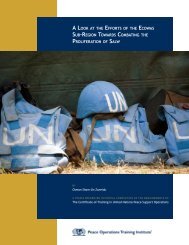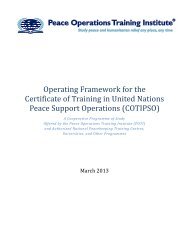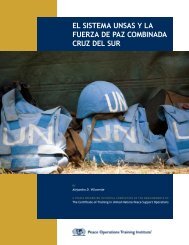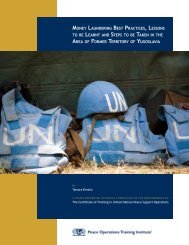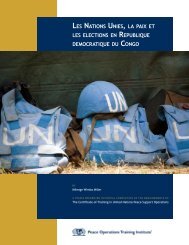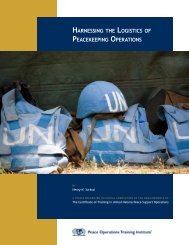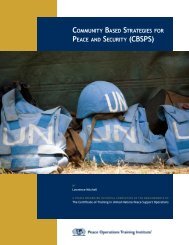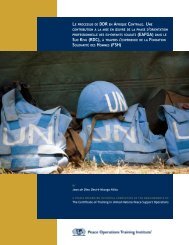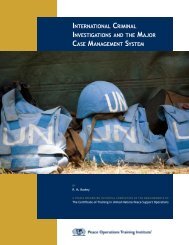Download - Peace Operations Training Institute
Download - Peace Operations Training Institute
Download - Peace Operations Training Institute
Create successful ePaper yourself
Turn your PDF publications into a flip-book with our unique Google optimized e-Paper software.
Implementation of Security CouncilResolution 1325 (2000) in Africa (New)[In English]Security Council resolution 1325 (2000), unanimouslyadopted in October 2000, sets out a policy framework forwomen and peace and security. This course introducesthe main principles of the resolution and provides practicalguidelines on how to implement it at the national level,including through the development of national action plans.While informative for any student interested in the topic,the course was especially designed for people who workat the highest decision-making levels, especially at thenational level, in Africa and who require a practical toolto support and facilitate the implementation of SCR 1325(2000). The course is based on background information,analysis, and a wide range of studies. The first threelessons focus more broadly on the issues of women, peace,and security; the UN’s role and views on the subject; andSCR 1325 (2000) itself. Within this context, Lessons 4and 5 highlight the challenges and priorities specific to theAfrican region. Lesson 6 examines the role of both regionaland subregional organizations in supporting nationalimplementation of the resolution. The final lesson providesguidelines for creating and implementing a national actionplan. Seven lessons, 244 pages.COURSE AUTHOR: The United Nations Entity for GenderEquality and the Empowerment of Women (UN Women)Implementation of Security CouncilResolution 1325 (2000) in Latin America andthe Caribbean[In English]This course, much like its sister course Implementationof Security Council Resolution 1325 (2000) in Africa,introduces the student to SCR 1325 (2000) and the policyguidelines it outlines on women and peace and security. AsImplementation of Security Council Resolution 1325 (2000)in Africa does, the first three lessons of this course focus onthe issues of women, peace, and security; the UN’s role andviews on the subject; and SCR 1325 (2000) itself. Withinthis context, Lessons 4 and 5 highlight the challenges andpriorities specific to the Latin American and Caribbeanregion. The final lesson provides guidelines for creatingand implementing a national action plan. Six lessons, 221pages.COURSE AUTHOR: The United Nations Entity for GenderEquality and the Empowerment of Women (UN Women)Preventing Violence Against Women andGender Inequality in <strong>Peace</strong>keeping[In English, French, and Spanish]Gender inequality and violence against women affect thelives of every person, regardless of age or gender. Thiscourse aims to assist peacekeeping personnel to promotethe human rights and security of women and girls. It doesso through lessons emphasizing the nature and scope ofviolence against women and girls around the globe, theconnections between gender inequality and violence in bothpublic and domestic spaces, as well as on interpersonal,community, national, regional, and international levels.Other lessons cover women’s rights as human rights andthe international UN mandate to involve women in keyroles within peacemaking and peacebuilding processes atevery stage and every level of authority. Readings and casestudies provide examples to assist peacekeeping personnelwith considering how they, as individuals and as teams, canwork to promote gender equality and to change the attitudesand behaviours that perpetuate violence. Ten lessons, 310pages.COURSE AUTHORS: AnnJanette Rosga, Ph.D., inassociation with Megan Bastick and Anja Ebnöther of theGeneva Centre for the Democratic Control of Armed Forces(DCAF).Gender Perspectives in United Nations<strong>Peace</strong>keeping <strong>Operations</strong> (Revised 9/2011)[In English, French, and Spanish]This course addresses the conceptual and operationalissues involved in integrating a gender perspective intomultidimensional peace operations. It describes theproblems related to gender within contemporary armedconflict by contextualizing the evolution of gender relationswithin the history of world conflict. The course alsoexplores many important concepts such as gender equity,gender balance, and gender equality, along with severalunderreported realities of conflict, such as sexual violenceagainst males and sexual exploitation and abuse committedby UN peacekeepers. Invoking the various UN and non-UNinstruments of human rights and gender equality, the courseemphasizes the need for women to play a strategic rolein all levels of decision-making in regional, national, andinternational institutes and mechanisms. Seven lessons,264 pages.COURSE AUTHOR: Ximena Jimenez, BS, MA, MSc.International Gender, Women, <strong>Peace</strong>, and SecurityConsultant to the UN, the Club of Madrid, and otherinternational organizations and universities.UN Photo #450281 by Olivier Chassot6



